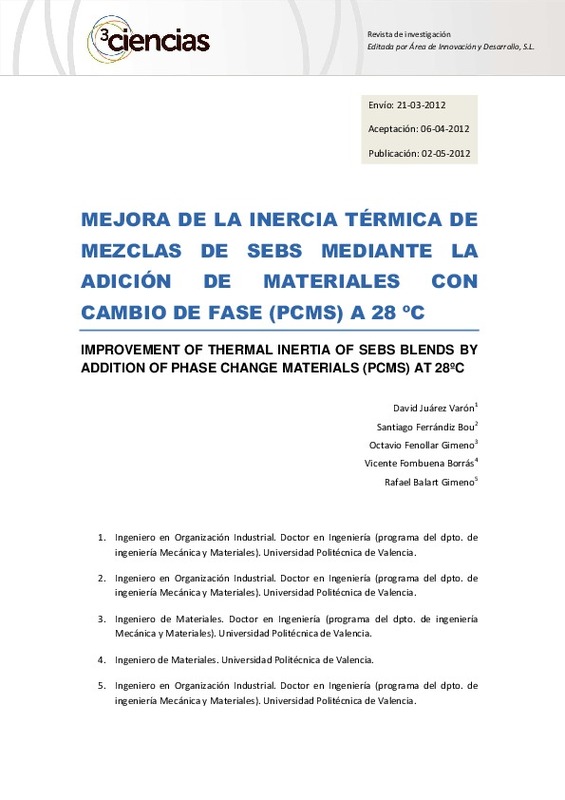Juárez Varón, D.; Ferrándiz Bou, S.; Fenollar, O.; Fombuena, V.; Balart, R. (2011). Improvement of thermal inertia of styrene-ethylene/butylene-styrene (SEBS) polymers by addition of microencapsulated phase change materials (PCMs). EUROPEAN POLYMER JOURNAL. 47(2):153-161. https://doi.org/10.1016/j.eurpolymj.2010.11.004
Por favor, use este identificador para citar o enlazar este ítem: http://hdl.handle.net/10251/31938
|
Título:
|
Improvement of thermal inertia of styrene-ethylene/butylene-styrene (SEBS) polymers by addition of microencapsulated phase change materials (PCMs)
|
|
Autor:
|

 Juárez Varón, David
Juárez Varón, David

 Ferrándiz Bou, Santiago
Ferrándiz Bou, Santiago

 Fenollar, O.
Fenollar, O.

 Fombuena, V.
Fombuena, V.

 Balart, R.
Balart, R.
|
|
Entidad UPV:
|
Universitat Politècnica de València. Departamento de Ingeniería Mecánica y de Materiales - Departament d'Enginyeria Mecànica i de Materials
|
|
Fecha difusión:
|
|
|
Resumen:
|
[EN] In this work, microencapsulated phase change materials (PCMs) with a melting temperature of 52 °C have been used to improve thermal inertia phenomena on an elastomeric matrix of styrene-ethylene/butylene-styrene (SEBS) ...[+]
[EN] In this work, microencapsulated phase change materials (PCMs) with a melting temperature of 52 °C have been used to improve thermal inertia phenomena on an elastomeric matrix of styrene-ethylene/butylene-styrene (SEBS) material. The amount of PCMs has varied in the 1-10 wt.% and these materials have been processed by conventional injection molding without PCM degradation. Mechanical characterization of SEBS-PCM compounds has been carried out and the obtained results show good maintenance of both resistant and ductile properties for PCM amounts comprised in the 1-5 wt.% range. Scanning electron microscopy (SEM) analysis has revealed good wetting properties of PCM microcapsules with the SEBS matrix which is a key factor to obtain good mechanical performance. The effect of PCM addition on thermal inertia has been evaluated by active infrared thermography (IRT), showing a remarkable effect on thermal regulation of SEBS in the temperature range close to the melting point of the PCM (52 °C). This thermoregulation effect is more accurate as the PCM content increases. Also, cooling curves have been constructed in order to quantify the thermal inertia effect in a cooling process. © 2010 Elsevier Ltd. All rights reserved.
[-]
|
|
Palabras clave:
|
Infrared thermography (IRT)
,
Phase change materials (PCM)
,
SEBS
,
Thermal inertia
,
Active infrared thermography
,
Conventional injection molding
,
Cooling curve
,
Cooling process
,
Ductile properties
,
Elastomeric matrices
,
Infrared thermography
,
Key factors
,
Matrix
,
Mechanical characterizations
,
Mechanical performance
,
Melting temperatures
,
Microcapsules
,
Microencapsulated phase change material
,
SEM
,
Temperature range
,
Thermal regulation
,
Wetting property
,
Bond (masonry)
,
Buoyancy
,
Germanium alloys
,
Injection molding
,
Mechanical properties
,
Melting point
,
Phase diagrams
,
Scanning electron microscopy
,
Styrene
,
Thermography (imaging)
,
Thermography (temperature measurement)
,
Phase change materials
|
|
Derechos de uso:
|
Cerrado |
|
Fuente:
|
EUROPEAN POLYMER JOURNAL. (issn:
0014-3057
)
|
|
DOI:
|
10.1016/j.eurpolymj.2010.11.004
|
|
Editorial:
|
Elsevier
|
|
Versión del editor:
|
http://dx.doi.org/10.1016/j.eurpolymj.2010.11.004
|
|
Código del Proyecto:
|
info:eu-repo/grantAgreement/MEC//DPI2007-66849-C02-02/ES/INVESTIGACION DE LOS MECANISMOS DE ACTUACION DE TRATAMIENTOS SUPERFICIALES, PARA LA CUANTIFICACION DE LA HIDROFILIDAD Y DURABILIDAD, APLICADOS SOBRE MATERIALES TEXTILES/
info:eu-repo/grantAgreement/GVA//FPA%2F2010%2F027/
|
|
Agradecimientos:
|
Authors thank "Ministerio de Ciencia y Tecnologia", Ref: DPI2007-66849-C02-02 and Generalitat Valenciana FPA/2010/027 for financial support.
|
|
Tipo:
|
Artículo
|






![[Cerrado]](/themes/UPV/images/candado.png)



